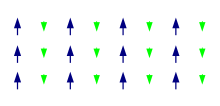
Back مغناطيسية فريتية Arabic Феримагнетизъм Bulgarian Ferrimagnetisme Catalan Ferrimagnetismus Czech Ferrimagnetismus German Ferrimagnetismo Spanish Ferrimagnetism Estonian Ferrimagnetismo Basque فریمغناطیس Persian Ferrimagnetismi Finnish


A ferrimagnetic material is a material that has populations of atoms with opposing magnetic moments, as in antiferromagnetism, but these moments are unequal in magnitude, so a spontaneous magnetization remains.[1] This can for example occur when the populations consist of different atoms or ions (such as Fe2+ and Fe3+).
Like ferromagnetic substances, ferrimagnetic substances are attracted by magnets and can be magnetized to make permanent magnets. The oldest known magnetic substance, magnetite (Fe3O4), is ferrimagnetic, but was classified as a ferromagnet before Louis Néel discovered ferrimagnetism in 1948.[2] Since the discovery, numerous uses have been found for ferrimagnetic materials, such as hard-drive platters and biomedical applications.
- ^ Spaldin, Nicola A. (2011). Magnetic materials : fundamentals and applications (2nd ed.). Cambridge: Cambridge University Press. ISBN 978-0-521-88669-7. OCLC 607986416.
- ^ Néel, M. Louis (1948). "Propriétés magnétiques des ferrites ; ferrimagnétisme et antiferromagnétisme" (PDF). Annales de Physique. 12 (3): 137–198. Bibcode:1948AnPh...12..137N. doi:10.1051/anphys/194812030137. ISSN 0003-4169. S2CID 126111103.